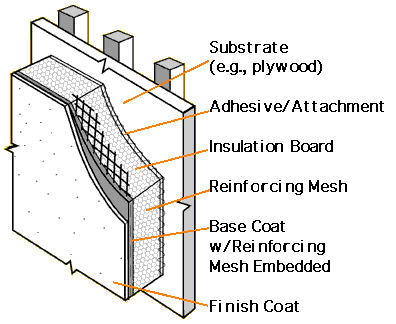Water Damage and EIFS
by Nick Gromicko and Ethan Ward
Synthetic Stucco
Synthetic stucco is quite different from historic stucco. Historic stucco is basically a plaster made with water, sand and lime. While the composition of stucco has changed over time, it has always been applied wet over a brick, stone or wood surface to form  the visible outside layer of a wall.
the visible outside layer of a wall.
Synthetic stucco is foamboard and fiberglass mesh attached to a wall that is covered with a polymer-based material which is then textured to look like historic stucco. It is technically known as an exterior insulation and finish system, or EIFS. It has been in use in Europe since the 1950s, and in the U.S. since the late ‘60s. It is often used on wood-framed houses.
Why is water damage a concern?
Any building material used on the exterior of residential homes will allow water or water vapor that finds its way inside to eventually escape back to the atmosphere. EIFS itself, however, blocks the movement of water and water vapor – it does not “breathe.” This, coupled with interior vapor barriers that are often required by building code, can lead to prolonged moisture intrusion and, eventually, rotting of materials.
Water can find its way inside through any cracks that have developed, or through any areas where the EIFS is jointed with a different material, such as door and window frames, or at the roof. If the EIFS continues below ground level, any cracks or openings in the finish will allow moisture, as well as wood-destroying organisms, such as termites, inside. When prolonged moisture intrusion of the wood behind the EIFS reaches 30%, rotting will occur.
Has water damage occurred or is it likely to occur?
A preliminary visual inspection may reveal if water damage is actively occurring, as well as whether it is likely to occur due to improperly installed synthetic stucco. There have been many reported cases of EIFS manufacturer installation instructions not being followed correctly by builders, leading to problems. It’s a good idea for inspectors to understand some of the methods of installation so that they can check some likely areas of moisture intrusion.
A few places to start visual inspection include:
-
ground contact: EIFS should not continue down a wall into the ground. It should terminate no less than 6 inches from finished ground level. The bottom lip of the EIFS should also be properly wrapped and sealed;
-
roof flashing: Kickout flashing should be installed where the EIFS meets the roofline. If this is missing, there is a good possibility that water is entering the wall cavity. Check for any areas that feel soft or are discolored;
-
joints around windows and doors: Check caulking joints around windows and doors to make sure that there are no cracks, even small ones. If wood on window or door frames feels soft, or it is discolored, water may have entered the wall assembly around the frame; and
-
areas of cracking or bulging: If there are cracks in the EIFS itself, moisture will be able to infiltrate the wall assembly and cause rotting. Bulges can indicate that coatings are delaminating or detaching from the polystyrene board. These would be causes for concern.
Inspection for Moisture Intrusion
If a visual inspection reveals any evidence of damage, or that the EIFS has been installed incorrectly, further inspection may be in order. An inspection for moisture intrusion consists of inserting a small probe through the outer wall into the frame area to determine the moisture content of the cavity. The probe will leave holes about 1/8-inch in diameter, which can be sealed afterward. The moisture readings can be gathered from typical problem areas, such as around windows and doors, roof eaves, near decks, and so on. Once a more precise estimate of damage is obtained, options for repair can be evaluated by the homeowner. These may include anything from additional caulking and sealing to removal and replacement of synthetic stucco sections. Therefore, it is best to catch any possibility of water damage to EIFS at the earliest stage possible, before any lingering moisture has had time to cause rotting.
Bookmark/Search this post with
 the visible outside layer of a wall.
the visible outside layer of a wall.